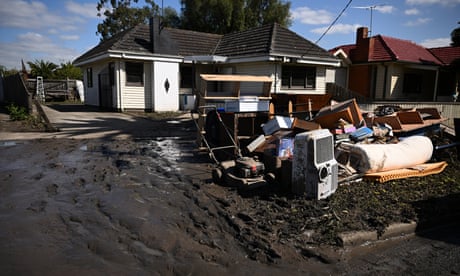- by foxnews
- 08 Apr 2025
Did the wall that saved the Melbourne Cup racetrack contribute to the flooding of 245 homes?
Did the wall that saved the Melbourne Cup racetrack contribute to the flooding of 245 homes?
- by theguardian
- 22 Oct 2022
- in news

As the people whose houses were swallowed by the Maribyrnong River dragged their ruined belongings into the street this week, until the piles of junk towered overhead, marquees were being erected downstream at Flemington racecourse.
Engineer Geoff Crapper met the Trewins during the battle against the wall, back in the early 2000s.
At the time, he had been a Melbourne Water employee for more than three decades, and was one of several experts who questioned the flood modelling relied upon by the authority to approve the wall.
He made five recommendations, including that the modelling be independently reviewed. Ultimately it was, but Melbourne Water still approved the wall.
He says this is what makes the investigation into the flood so critical: it will be the only way to determine what happened.
Investigators, he says, should be going into every house that flooded to determine the level the water reached, starting from Chifley Drive in the north, then moving downstream to measure levels at the wall itself, through the Kensington Banks estate, parts of which were also flooded, and at other markers as far down as Footscray Road.
Crapper reckons it is not just the flood wall that must be examined.
The hydrology and flood warning specialist says it appears warning systems failed, leaving residents in Maribyrnong with little time to flee, and there should be a serious discussion about whether the river should be dammed upstream at Arundel, as he first proposed in 1976.
Also in that government was Daniel Andrews, now the premier, who was steadfast in maintaining this week that the investigation would be independent.
Thwaites has excused himself from any involvement in the review to avoid any potential or perceived conflicts of interest.
That does little to comfort Ted Baillieu, the former Liberal premier who was shadow planning minister when the wall was approved.
But they were united in their belief that the planning case for the wall did not stack up.
A condition of the planning permit issued to the Victorian Racing Club was that the wall would not cause further flooding, Baillieu says.
Should the investigation find that it did, the government and racing club could be sued by property owners. Carbone Lawyers is reportedly considering a class action on their behalf, but the firm did not respond to Guardian Australia.
Melbourne Water had no objection to the amendment, saying, according to council documents, it was satisfied the wall and other mitigation works against a one-in-100-year flood had negated the need for such assessments.
Baillieu says these consequences have been so grave that the inquiry had to consider who, if anyone, was ultimately accountable.
- by foxnews
- descember 09, 2016
Ancient settlement reveals remains of 1,800-year-old dog, baffling experts: 'Preserved quite well'
Archaeologists have recently unearthed the remarkably well-preserved remains of a dog from ancient Rome, shedding light on the widespread practice of ritual sacrifice in antiquity.
read more


